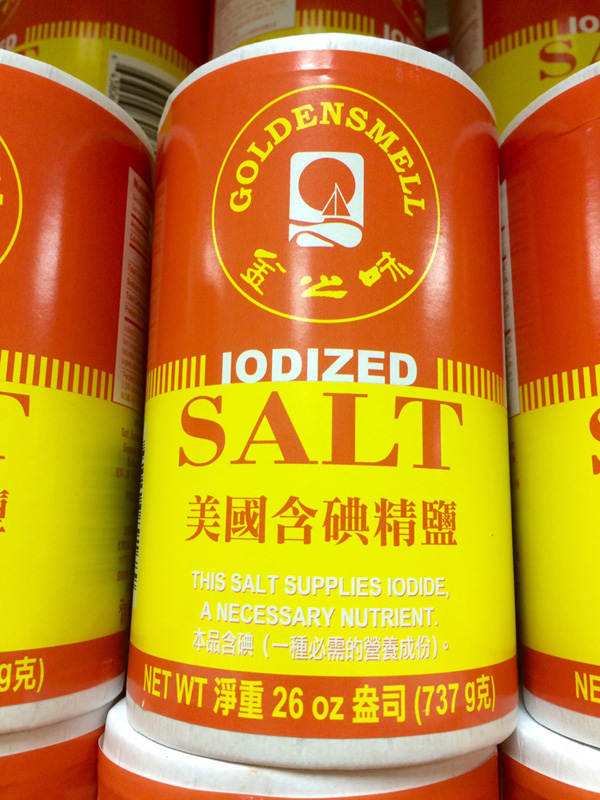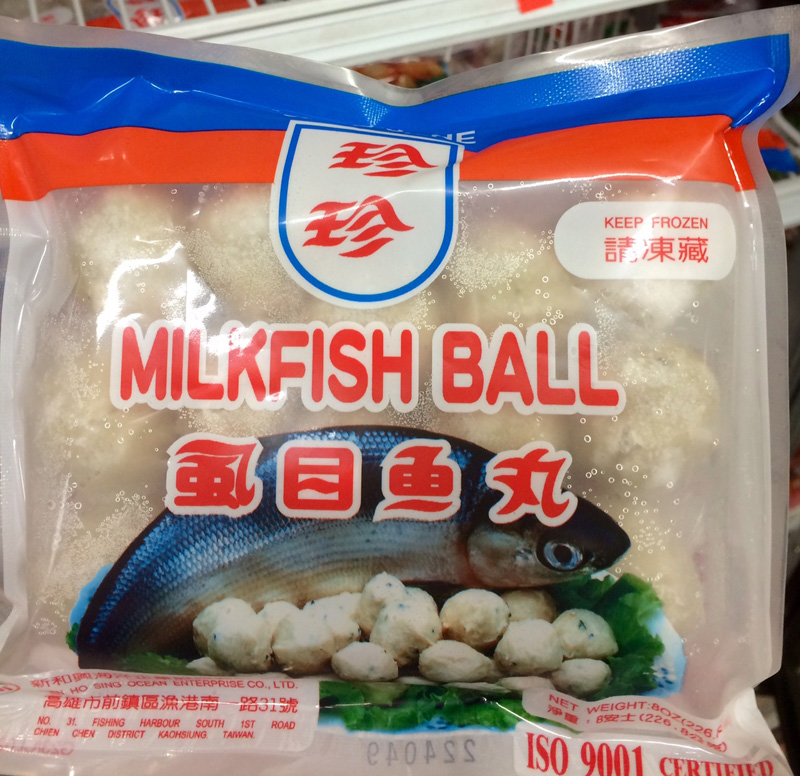Goldensmell salt and milkfish balls
« previous post | next post »
Jackie and Mimi, Toni Tan's daughters, spotted two interesting products at the Asian supermarket near their home.
The operative readings on the respective packages are:
jīnzhīwèi 金之味 ("golden taste")
shīmùyúwán 虱目鱼丸 (lit., "louse / cootie eye fish ball")
The glitch with the first translation is due to the wrong choice among the various meanings of wèi 味 ("flavor; taste; smell; odor").
Unfortunately, there's not much you can do with shīmùyú 虱 目鱼, because it really is the "Chinese" name for the milkfish (Chanos chanos). I'm unaware of other English names for this fish, and the Japanese seem just to call it sabahī サバヒー (I'm waiting on Japanese ichthyologists and lexicographers to explain the full derivation of that term, though it seems to me to be simply a katakana transcription of the Taiwanese name on the package), but it would appear that not everybody in China thinks its eyes look like those of a cootie / louse, since there are so many other radically different names that it goes by in "Chinese":
(translations are literal)
hǎicǎo yú 海草魚 ("seaweed fish")
ānpíng yú 安平魚 ("peace fish" — though this might be a place name)
guóxìng yú 國姓魚 ("national surname fish")
máshī mù 麻虱目 ("hemp louse eye") — this is a Taiwanese word, so it should be pronounced muâ-sat-ba̍k
máshī mù zǐ 麻虱目仔 ("hemp louse eye diminutive suffix ") — this is also a Taiwanese word, so it should be pronounced muâ-sat-ba̍k-á
zhēmù yú 遮目魚 ("covered eye fish")
zhuàngyuán yú 狀元魚 ("champion fish") — I've been told that this is a new term coined on the Mainland to make the fish sound more appealing for marketing purposes, since "cootie eye fish" is not very attractive to people who don't speak Taiwanese.
niúnǎi yú 牛奶魚 ("milkfish" — translation from the English)
Aside from the two Taiwanese names, which I did catch, some of the others may also be topolectal, thus Mandarin would not be the best pronunciation for them, and they may have local or regional nuances that I am unfamiliar with.
In Taiwanese, the usual word for this fish is sat-ba̍k-hî / sat-ba̍k-hû. Some Taiwanese scholars hold that since the milkfish is called sabalote in Spanish (it is also called pez-de-leche), it may have been transcribed this way during the colonial period. There are other theories concerning the origin of the Taiwanese name, including that it comes from a substrate Siraya word, particularly when it has the prefix muâ 麻, which I don't think really means "hemp", but is being used for transcriptional purposes.
N.B. The MSM term for "louse; cootie" is shī 虱 (common variant 蝨) or shīzi 虱子 (with noun suffix added). Half a dozen additional variants for 虱 may be found here.
This is as far as I got in my own researches last night, but when I woke up this morning, I found the following wonderful notes from Michael Cannings:
Milkfish appears to have been farmed in southwestern Taiwan since at least the days of Zheng rule (1662–1683).
The online Catalog of Life in Taiwan contains the following theories on the origins of the name:
而 有關於此魚諸多魚名的由來,流傳甚多,
So in summary we have four proposals:
- It's a loanword from an aboriginal language, presumably Siraya.
- It's a loanword from the Spanish sabador. While the modern Spanish appears to be sabalote, not sabador, that would still fit as a phonetic loan.
- Fanciful tale about someone mishearing Koxinga (Zheng Chenggong) asking "what fish is that?" as "sat-ba̍k-hî". Cf. urban legends about the etymology of "kangaroo".
- Description of the fish's eyes going cloudy after it's caught.
If I had to put money on one of the four, I'd go with number one: aboriginal loan. Unfortunately I don't have access to a Siraya dictionary, which might otherwise help to add weight to that hunch.
Milkfish is one of those animals with lots of different names in Taiwanese. A lot of local flora and fauna doesn't have standardised names, and names can overlap with completely different species.
My dictionary lists seven:
- an-pêng-hî 安平魚 [Anping fish]
- hái-chháu-hî 海草魚 [seaweed fish]
- hái-liân 海鰱 [sea-lian]
- môa-sat-ba̍k 麻 虱目
- môa-sat-ba̍k 鰻 虱目
- sái-hî 屎魚 [shit fish]
- sat-ba̍k-hî 虱目魚
Add in Lian Heng's 麻薩末 môa-sat-boa̍t to make eight – with 4 and 5 above collectively they add weight to the phonetic loan theory. In which case the 麻虱 of your question doesn't "mean" anything.
Online searches reveal a few more names, including 遮目魚 ("covered eye fish"), 國姓魚 ("national surname fish"), 殺目魚 ("kill eye fish"), and 塞目魚 ("stuffed eye fish"). (VHM: tentative, literal translations provided by me.) The most common nowadays is, I think, sat-ba̍k-hî 虱目魚. This could be a contraction of the original môa-sat-ba̍k, with hî ("fish") added as an identifier.
The 仔 suffix is pronounced á, and is a dialect variation. This is true of many animal names in Taiwan – some topolects prefer to add á, others prefer not to.
There's not much more that needs to be said after all that, except:
- Fish terms around the world, but especially in East Asia, tend to be, uh, as one might put it, rather slippery and shoal-like, as we have seen in posts such as this one: "Japanesespanishmackerel " (11/13/13).
- There probably are still more terms for Chanos chanos in Sinitic languages and topolects, not to mention the non-Sinitic languages and topolects of the region.
- The taxonomists responsible for the scientific term for the milkfish — Chanos chanos — were simply repeating a Greek word meaning "mouth", so they were focusing on a different part of the fish's anatomy than are indicated by many of the "Chinese" names.
- It's a good thing that the Taiwanese didn't decide to market the milkfish balls as being made from sái-hî 屎魚 ("shit fish").
[Thanks to Sophie Wei, Grace Wu, Melvin Lee, and Chia-hui Lu.]


Michael Cannings said,
June 29, 2015 @ 10:12 am
I should add that 國姓魚 is probably named for Zheng Chenggong. His common moniker in the West, Koxinga, is a transliteration of 國姓爺 Guóxìngyé, or "Gentleman of the Imperial Surname", an honour accorded to him by the Longwu Emperor which allowed him to ceremonially use the imperial family's name, Zhū 朱.
leoboiko said,
June 29, 2015 @ 10:48 am
Japanese Wikipedia agrees that sabahī is from the Taiwanese/Min name. It also mentions two theories about the origin of the name:
– From Adachi Noriyuki: it was originally 塞目魚 "covered-eyes fish", due to a fat membrane covering its eyes; the first character was later substituted by homophonous 虱.
– A popular legend similar to the "kangaroo" one: When Zheng Chenggong tried the fish he asked, in a Min dialect, "what is this fish called" = 啥咪魚 and the people around it mistook him to be saying it was a "siáⁿ-mi-hî".
Ralph Hickok said,
June 29, 2015 @ 10:58 am
I don't eat imaginary foods. I don't eat buffalo wings because buffalo don't have wings, I don't eat chicken fingers because chickens don't have fingers, and I don't eat fish balls.
Rubrick said,
June 29, 2015 @ 8:17 pm
It's interesting that "golden taste" sounds fine (to my American ears), but "golden smell" sounds awful (impressionistically, not grammatically).
maidhc said,
June 30, 2015 @ 4:13 am
Rubrick: "Smell" and "odor" are just as frequently used for unpleasant smells as for good ones. You made me think how would one go about scripting a MacDonald's commercial?
"Mmm, somethin' smells good! What's a-cooking?"
"That's the Golden Smell of the Golden Arches!"
Announcer: "Yes, that's the golden smell of these golden French fries, freshly cooked in saturated fat and lightly dusted with an unhealthy amount of salt!"
It needs a lot of work. But the first challenge would be coming up with a replacement for "smell".
Alan Palmer said,
July 3, 2015 @ 4:22 am
From maidhc:
'Odour' (or, in American English, 'odor'), 'scent' and 'fragrance' come to mind. The latter, in particular, is beloved of ad executives at present.